Abstract: The ‘Beti Bachao Beti Padhao’ Scheme was launched for the protection and education of girl children. Its outcome remains sub-optimal with disproportionate amounts being spent on media advocacy rather than on health and educational requirements. While there are a large number of similar schemes with near identical objectives in almost all states, there is no attempt to strike a synergy between the state and central schemes for optimal utilisation of public funds; most states also lack the capacity and resources to produce perceptible impact. As in the past, Central schemes continue to proliferate mindlessly without any systematic evaluation of their efficacy, which remains an abiding aberration in our public financial system.
Preference for a male child is ingrained in India’s DNA and the Child Sex Ratio (CSR) of India has been falling continuously for decades, from 976 in 1961 to 927 in 2001 to an all-time low of 918 in 2011, with wide variation across states. Between 2001 and 2011, 21 out of 28 states registered a decline in the CSR. In terms of the World Economic Forum’s Global Gender Gap ranking in 2021, India with rank of 140 out of 156 countries was one of the worst performers in South Asia, behind Bangladesh, Nepal, Bhutan and Myanmar. To ensure coordinated and convergent efforts for survival, protection and education of the girl child, ‘Beti Bachao Beti Padao’ (BBBP), a Centrally Sponsored Scheme (CSS) was launched in 100 selected low-CSR districts in the first phase in 2015. It was subsequently extended to 61 more districts in the second phase. The scheme was well-received and in view of the criticality of CSR, it has subsequently been implemented across India covering 640 districts (as per census 2011). A joint initiative of the Ministries of Women and Child Development (MoWCD), Health and Family Welfare (MoHFW) and Education (MoE) and implemented through State Governments/Union Territories (UTs) through District Collectors/District Magistrates, the scheme is fully funded by the Union Government from the MoWCD budget and seeks to address the declining Child Sex Ratio (CSR) and related issues of women empowerment over a life-cycle continuum.
The overall goal of the scheme is to celebrate the girl child and enable her education with a strong emphasis on changing the attitude of society through media campaigns to sensitise people, raising their awareness and community mobilization. Specified objectives of the scheme are prevention of gender biased sex-selection through enforcement of Pre-Conception and Pre-Natal Diagnostic Technique Act (PCPNDT), ensure survival and protection of the girl child and her education. The scheme has two key components: (1) a nation-wide mass communication campaign to increase awareness and (2) multi-sector interventions at district level to improve education and health outcomes for the girl child. The mass media advocacy campaign aimed at ensuring that girls are born, nurtured and educated without discrimination to become empowered citizens of this country with equal rights, with a 360 degree media approach interlinking national, state and district level interventions with community level action in the selected districts, and bringing together different stakeholders for accelerated impact. Under the multi-sectoral interventions, coordinated and convergent efforts are undertaken by the ministries involved to ensure survival, protection and education of the girl child.
The major targets were to improve the Sex Ratio at Birth (SRB) in selected gender critical districts by 2 points a year and increase enrolment of girls in secondary education to 82 percent by 2018-19. Other monitorable targets included reducing gender differentials in Under-Five Child Mortality Rate from 7 points in 2014 to 1.5 points per year, at least 1.5 percent increase per year of institutional deliveries, providing functional toilet for girls in every school in selected districts, training elected representatives/ grassroots functionaries as community champions to mobilize communities to improve CSR and promote girls’ education, etc. Progress of the scheme is measured from annual SRB data collected by the Health Management Information System (HMIS) of MoHFW.
BBBPS is now being operated and implemented under the Centrally Sponsored Scheme. Till 2020-21 the outlay and expenditure of the scheme were appearing in the budget documents after which it was merged with different umbrella schemes, like SAMARTHYA[2] in 2021-22 and SAMBAL[3]; both these schemes now come under another umbrella scheme, Mission Shakti for Protection and Empowerment for Women which also includes the Nari Adalat for facilitating gender justice. The allocation and expenditure figures are not available separately in the budget anymore or even in the Detailed Demands for Grants. This continuous jugglery defies logic and introduces opacity for the closer scrutiny of outlays and outcomes of government schemes about their effectiveness and relevance. Table 1 shows the budgetary allocations and expenditure on BBBP since inception.
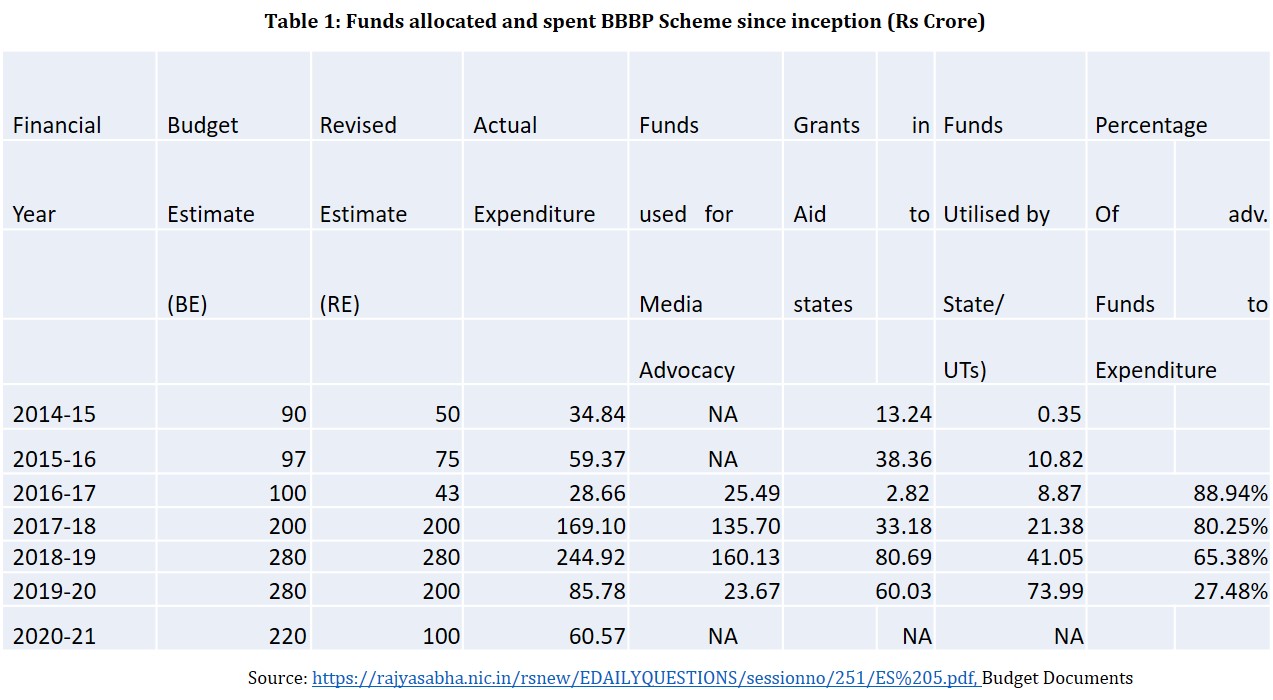
The Parliamentary Committee on Empowerment of Women through Education headed by the BJP MP Heena Vijaykumar Gavit[4] examined the BBBP scheme. Its report submitted in December 2021 pointed to the excessive and disproportionate amount of funds being spent on media advertisements. While poor utilisation was reported from the states, funds released for media advocacy campaign were fully utilised. While a quota of 50 percent was fixed in the scheme for innovation/awareness generation activities, the Committee noted that “allocated funds were poured into advertisements far above this quota” using public money unreasonably. Its report castigated the Government: “The Committee understands that the BBBP scheme is implemented with 100% central assistance. Rupees Fifty Lakh per year is earmarked per districts for utilisation under six different components, viz. 16% for inter-sectoral consultation/ capacity building, 50 % for innovation/ awareness generation activities, 6% for monitoring and evaluation, 10% for sectoral interventions in health, 10% for sectoral interventions in education and 8% as flexi funds. The Committee finds that out of a total of Rs. 446.72 crore released[5] during the period 2016- 2019, a whopping 78.91% was spent only on media advocacy.”
The CAG Report No. 1 of 2017 for the Government of Haryana for 2015-16[6] which assessed the BBBP also concluded that there was a scope for improvement in implementation in respect of CSR and enrolment n secondary education, that infrastructure to prevent gender biased sex selection under PCPNDT was not adequate and girls who dropped out in some districts were not fully re-enrolled. CAG has not done any further review of the scheme since.
As regards outcome of BBBP, the latest NHFS-5 data show improvement of CSR from 919 in 2015-16 to 929 in 2019-20. Table 2 shows the change in Gross Enrolment Ratio (GER), CSR, etc. between 2015-16 and 2019-20. GER has in fact declined in 18 out of 36 states/UTs in 2018-19, contributing to overall decline at the national level. The Ministry of Education has identified the lack of infrastructure and toilet facilities, early marriage and low aspirations of girls as some of the causes for this decline, excluding the cost of education in terms of uniform, books etc, as these are taken care of by the Samagra Shiksha Abhiyan (SSA).[7]
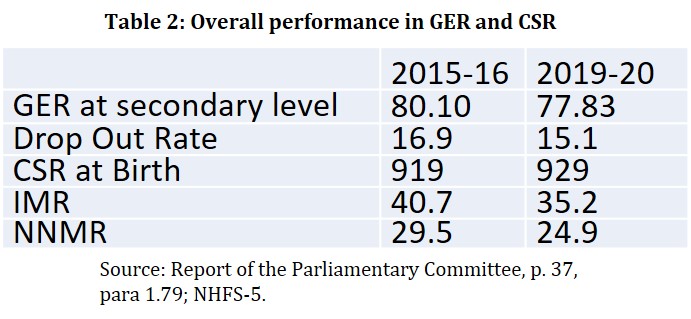
However, it was noticed that some states have fared better than the others. The MoWCD had felicitated the following 5 states for consistent improvement in sex ratio, as shown in table 3:

But overall, though the position has improved in most states, 10 states including economically advanced states like Goa, Maharashtra, Kerala and Tamil Nadu showed a decline between NHFS-4 (2015-16) and NHFS-5 (2019-20) as shown in table 4. Even in a state like Meghalaya which is one of the last bastions of matriarchal society and where women enjoy greater liberties and respect than in most mainstream states, CSR has fallen from 1009 to 989. In general, after 2011, before BBBP was launched but several state government schemes for improving CSR were operational, it witnessed a descent growth for the first few years, showing good results even in states which were traditional laggards like Haryana, with its CSR (0–6 age group) crossing 900 mark for the first time in 2015 in 15 years, but the trend could not be maintained uniformly by all the states.
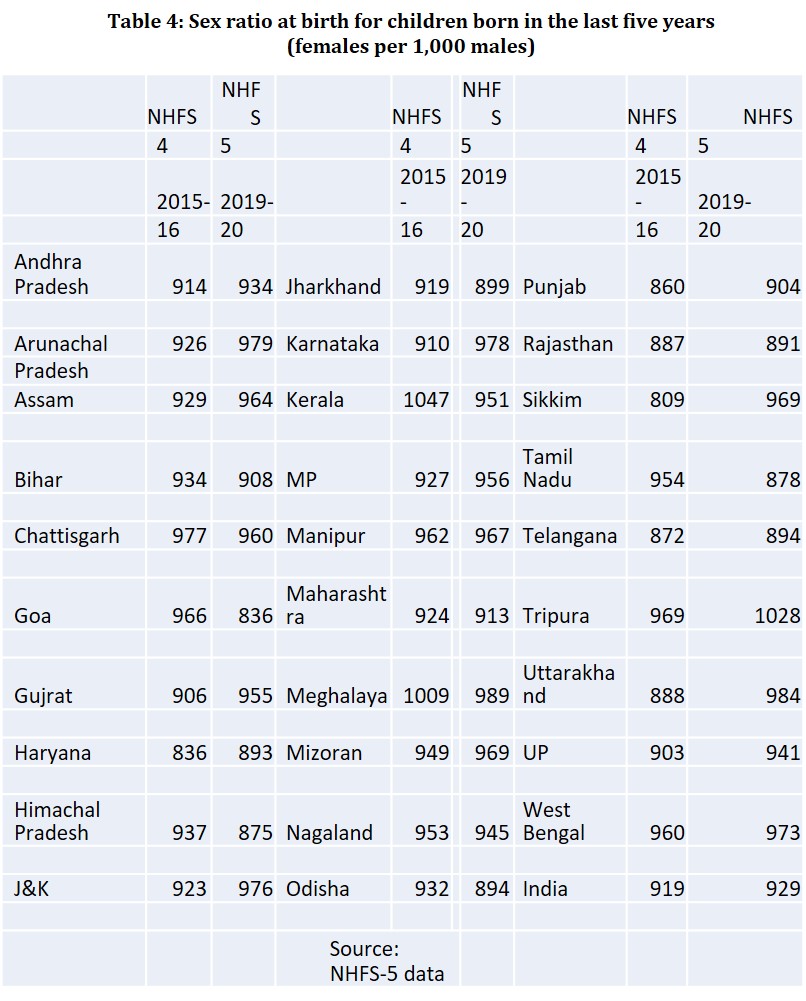
Since both GER and CSR are functions of many variables, the wide variation in performance across the states cannot really be attributed to the success or failure of BBBP scheme alone, though it would make some contributions in improving performance. There were rural-urban divergences, with urban areas faring better in most states. Still why some states including the advanced states showed decline in performance remains a question that needs to be addressed seriously. It certainly indicates that the BBBP and its media awareness campaigns on which so much money was spent did not produce optimum results. For example, CSR in Tamil Nadu improved from 942 females in 2001 to 946 females in 2011. Of the 14 districts that showed a decline in the CSR from 2001 levels, the worst was Cuddalore which recorded a dip from 957 in 2001 to 895 in 2011, followed by Ariyalur (949 to 892). Cuddalore was included in the first phase of BBBP, while Ariyalur, Chennai, Tiruvallur, Tiruvannamalai, Villupuram, Trichy and Perambalur were included in the second, along with three more: Namakkal, Salem and Dharmapuri which had also shown a decline in CSR between the two censuses. These 11 districts covered more than 40 percent population of the state. Yet the CSR for Tamil Nadu as a whole has recorded a steep decline from 954 to 878 between 2015-16 and 2019-20. This indicates that some other effective intervention is needed.
Besides inefficient allocation and release of funds with only 5 percent of the funds spent on education, in stark contrast to media advertisements, CAG and media reports also pointed to insufficient monitoring and oversight, particularly at the district level, highlighting the need to increase expenditure on health and education-related interventions including improvement of the girls’ nutritional status, involvement of local frontline workers, training of ground staff, involvement local NGOs and greater use of mobile technology to increase outreach and also for better monitoring and documentation.[8]
But the real issue at stake is the efficiency of public expenditure, which raises questions about the lack of synergy between the centre and the states and overlap of similar schemes with identical objectives. This leads to suboptimal use of public funds at both the central and state levels. It would seem that schemes have been launched primarily on political considerations with inadequate analyses of their rationale and impact on the target beneficiaries.
Almost all states have similar schemes for the girl child and women with identical objectives as the BBBP, as can be seen from the sample below:-
- To empower girl students; reduce gender gap in academic institutions and reduce dropouts; (Mukhyamantri Balika Cycle Yojana, Bihar, 2006; Saraswati Bicycle Yojana, Chhattisgarh, 2004-05)
- To raise the status of girl child in family and society; change mindsets of people for proper rearing of girl children; improve the declining sex ratio of females and increase the number of girls in families, etc; (Aapki Beti Hamari Beti, 2015, Haryana; Bhagyalaxmi scheme, Karnataka, 2006-07)
- To improve health and educational status of girls; prevent female feticides; change people’s attitude towards girl child; prevent child marriages; (Ladli Laxmi Yojana, MP; Sivagami Ammaiyar scheme, Tamil Nadu)
- To improve the status and well-being of girl child by incentivizing them to continue in education for longer period till secondary or higher secondary or equivalent in technical or vocational steams of education; disincentivise marriage till 18 years; empower girls by paying benefits directly to their bank accounts; reinforce the positive impact of increased education and delayed marriages through targeted behaviour-change communication strategy, etc. (Kanyashree Prakalpa, West Bengal; Girl child Protection Scheme, Andhra Pradesh, 2004-05)
- To enhance the social status of girl child, ensure proper education to make her self-reliant; ensure her economic security; protect her from discrimination and deprivation. (Ladli Scheme, Delhi, 2008)
These common objectives between state schemes also overlap the objectives of many central schemes like the BBBP or SSA, etc. These schemes, most of which are meant primarily for the BPL or SC/ST families, broadly fall into three categories (with some overlaps between these):
- Since it is primarily due to the huge expenses associated with marrying a daughter that a family prefers a boy over a girl child, many of the schemes are designed to assist the family at the time of marriage by providing financial assistance when the girl attains marriageable age or are about to be married. Usual practice is to open a fixed deposit / LIC policy when the girl is born which will mature after 18 years, while some states also provide financial assistance which are often too meagre (say, Rs 5000 only) to be of any real help; Schemes like Mukhyamantri Kanya Bibaha Yojana, Bihar; Rupashree Prakalpa, West Bengal; Ladli Scheme, Delhi; Mazi Kanya Bhagyashree scheme, Maharashtra; Kanya Jagriti Jyoti Scheme, Punjab; Ladli Laxmi Yojana, MP; Mukhyamantri Laadli Yojana, Jharkhand; Girl Child Protection Scheme, Andhra Pradesh, etc., fall in this category.
- These are schemes meant for empowerment of girls through education while remaining unmarried, either through scholarships from the secondary/ intermediate stage to the graduation level, with scholarships increasing progressively with higher levels of education. Schemes for providing bicycles also fall within this category which have been found highly successful in their impact, not only for preventing drop-out rates but also for helping change the societal attitude towards girls.
Schemes like Mukhyamantri Balika Cycle Yojana, Bihar; Mukhyamantri Kanya Utthaan Yojana, Bihar; Saraswati Bicycle Scheme, Chhattisgarh; Beti Hai Anmol, Himachal Pradesh; Ladli Beti Scheme, Jammu & Kashmir; Mukhyamantri Laadli Yojana, Jharkhand; Bhagyalaxmi scheme, Karnataka; Ladli Laxmi Yojana, MP; Kanya Jagriti Jyoti Scheme, Punjab; Mazi Kanya Bhagyashree scheme, Maharashtra; Mukhyamantri Rajshri Yojana, Rajasthan; Bangaru Thalli Scheme, Telangana; Bhagyalakshmi Yojana, UP; Mukhya Mantri Kanya Sumangala Scheme, UP; Nanda Gaura Devi Kanya Yojana, Uttarakhand; Kanyashree Prakalpa, West Bengal; Ladli Scheme, Delhi, etc., fall within this category.
- There are also schemes designed to improve the sex ratio and to prevent female feticide, which incentivise parents by providing health insurance cover for the girl child and encourage them to adopt family planning measures after the birth of two girl children. Some states simply provide a sum, nominal again, after the birth of the girl child;
Schemes like Girl Child Protection Scheme, Andhra Pradesh; Indira Gandhi Balika Suraksha Yojana, Himachal Pradesh; MAMTA Scheme For Girl Child, Goa; Mukhyamantri Kanya Suraksha Yojana, Bihar; Kunwarbai Nu Mameru Scheme, Gujarat; Aapki Beti Hamari Beti, Haryana; Bhagyalaxmi scheme, Karnataka; Balri Rakshak Yojana, Punjab; Mukhyamantri Rajshri Yojana, Rajasthan; Sivagami Ammaiyar Scheme, Tamil Nadu, etc., fall within this category.
Many states lack resources and the capacity to intervene meaningfully to make a difference to the girl child and produce perceptible impact. The capacity and resources also vary significantly from state to state. A typical budget for most of these schemes for a poor state would be well below Rs 100 crore – which may not be adequate for bringing about a permanent social change. They also lack visibility to attract potential beneficiaries who may be unaware of their existence. All these schemes need integration with similar Central schemes and much better synergy for optimal utilisation of public funds.
Governments have a natural tendency to proliferate schemes by continuously adding to existing schemes without evaluating their efficacy or attempting to increase their efficiency. Once there were as many as 360 CSS; after the NDA government came to power, these were restructured into three categories with different funding patterns and their numbers were reduced to 30 by bunching many of them together, though the actual numbers remained high. Under the restructured pattern, there were: (1) six “Core of the Core” schemes: MNREGA, National Social Assistance Programme and four ‘umbrella schemes” for the development of minorities, SCs, STs and other vulnerable groups; (2) twenty-two “Core” schemes and (3) two “Optional” schemes. While “Core of the Core” schemes remained the same in number, “Core” schemes have now proliferated with funds being allocated to as many as 38 such schemes; some of these are again a combination of several schemes, like Umbrella ICDS or Mission Shakti as discussed earlier, and this is not all. Statement number 48 of the 2022-23 budget shows as many as 740 central sector schemes, some of them without allocations, under demands for grants of different ministries. Here again there is an obvious lack of synergy. A scheme represents public policy and every government, state or central, has the necessary authority and mandate to design and implement any scheme. But the question is one of efficiency in public expenditure both in the centre and the states. The multiplicity of such schemes, their mindless proliferation and wastage of public funds due to suboptimal delivery or impact of these schemes are aberrations in our public financial system. Neither is there a regular institutional mechanism nor a defined procedure to evaluate their efficacy. Such evaluation is usually done in ad-hoc manner through engagement of third parties – either on nomination basis or by inviting tenders. The result of such evaluation is often suspect as the evaluating agencies remain vulnerable to pressures by an interested executive to show the schemes as effective and hide their deficiencies and the results are not put in the public domain. Ministries use these evaluations as justifications for continuing with the schemes and making expenditure which may serve the political purposes of incumbent governments.
It is therefore, suggested that where state schemes serve common objectives across the country, they should be implemented as CSS leaving the states free to focus on other important areas. That way scale and efficiency can be achieved while ensuring involvement and cooperation of the states. As regards the existing CSS and Central Sector Schemes, there is an urgent need to evaluate these in a transparent manner either through the Comptroller & Auditor General of India or an independent agency. There should also be a statutory independent council represented by both the centre and the states to review the schemes periodically. This will enhance both the allocative efficiency of public expenditure and the spirit of cooperative federalism while ensuring the optimal value for money of taxpayers’ funds.
Endnotes :
[1]Author is a retired Director General from the Office of the Comptroller & Auditor General of India currently engaged in academics.
[2]Includes BBBP, Creche, Pradhan Mantri Matru Vandana Yojana, Gender Budgeting, etc.
[3]Includes BBBP, One Stop Centre, Nari Adalat, Mahila Police Volunteer, etc.
[4]http://164.100.47.193/lsscommittee/Empowerment%20of%20Women/17_Empowerment_of_Women_5.pdf
[5]Actually Rs 442.68 crore, as per budget documents and accounts.
[6]https://cag.gov.in/uploads/download_audit_report/2017/Haryana_Report_1_of_2017_Non_PSUs_SGE_Sectors.pdf
[7]Report of the Parliamentary Committee, p. 37, para 1.78.
[8]Beti Bachao Beti Padhao – A critical review of implementation (indiatimes.com), Times of India, Jan 4 2019.
(The paper is the author’s individual scholastic articulation. The author certifies that the article/paper is original in content, unpublished and it has not been submitted for publication/web upload elsewhere, and that the facts and figures quoted are duly referenced, as needed, and are believed to be correct). (The paper does not necessarily represent the organisational stance... More >>
Image Source: https://feminisminindia.com/2018/05/22/beti-bachao-beti-padhao/

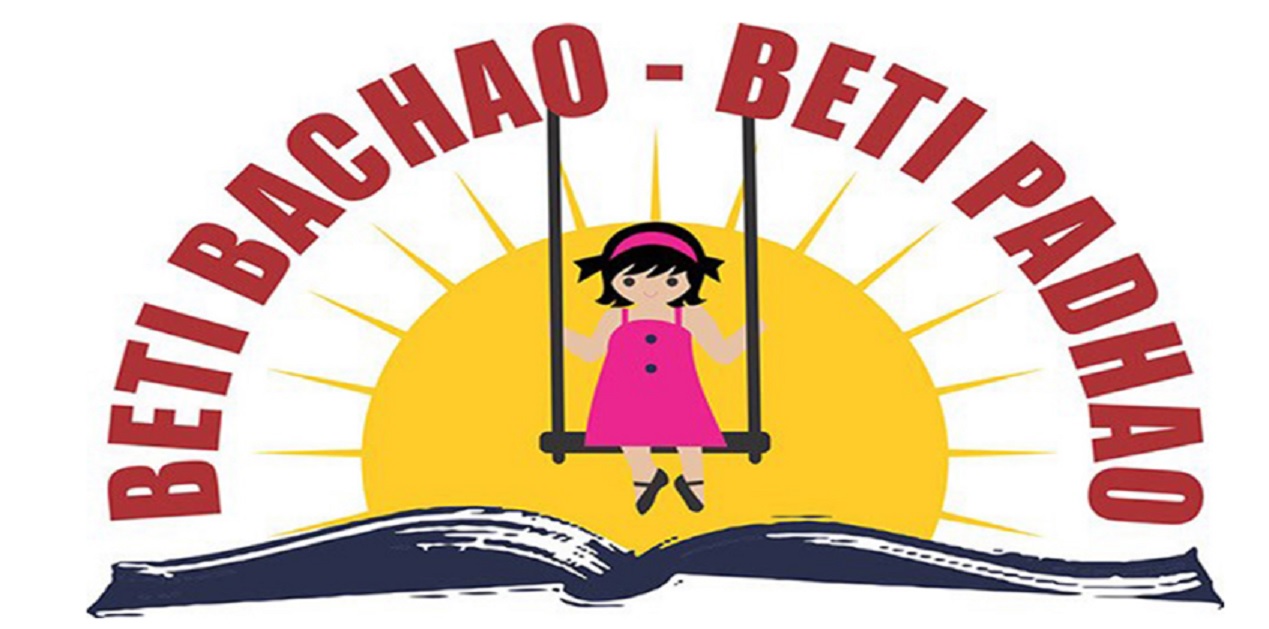
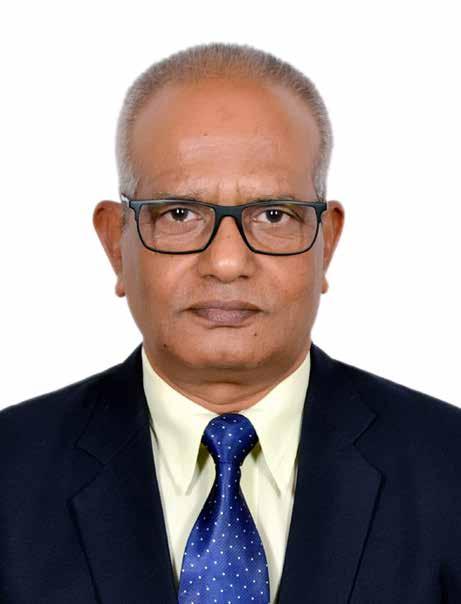







Post new comment